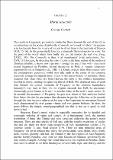Files in this item
Moral structure
Item metadata
| dc.contributor.author | Corbett, George | |
| dc.contributor.editor | Barański, Zygmunt | |
| dc.contributor.editor | Gilson, Simon | |
| dc.date.accessioned | 2019-06-27T23:38:09Z | |
| dc.date.available | 2019-06-27T23:38:09Z | |
| dc.date.issued | 2018-12 | |
| dc.identifier | 249567614 | |
| dc.identifier | b4f08435-42f2-4564-b9be-fa9b486a95df | |
| dc.identifier | 85141228662 | |
| dc.identifier.citation | Corbett , G 2018 , Moral structure . in Z Barański & S Gilson (eds) , The Cambridge Companion to Dante's Commedia . Cambridge Companions to Literature , Cambridge University Press , pp. 61-78 . https://doi.org/10.1017/9781108367769.007 | en |
| dc.identifier.isbn | 9781108421294 | |
| dc.identifier.isbn | 9781108367769 | |
| dc.identifier.other | ORCID: /0000-0002-7043-3253/work/52089207 | |
| dc.identifier.uri | https://hdl.handle.net/10023/17996 | |
| dc.description.abstract | Chapter 12 provides a comprehensive overview of the moral structure of each of the three realms of Dante’s afterlife: Hell, Purgatory and Paradise. It examines Dante’s sources, ethical criteria, and topography, as well as his representation of moral structure in the narrative itself, and its political implications. The first section analyses the four principal regions of Hell through Virgil’s rationale: the circles of incontinence, the ‘rings’ of violence, the ‘pouches’ of simple fraud, and the pit of treacherous fraud. It then explores the three groups of souls that Virgil strikingly leaves out: the ‘neutrals’, the virtuous pagans in Limbo, and the heretics. The second section addresses four key differences between Infernal and Purgatorial suffering, explains the moral theories of disordered love and the seven capital sins underpinning the seven terraces of Dante’s Purgatory, and examines the theologically original antechamber of Purgatory, and the Earthly Paradise at the mountain’s summit. The third section highlights Dante’s distinction between what Paradise is and how it is conveyed, and shows how his layered vision of Paradise overlaps the scheme of the four cardinal and three theological virtues with the theory of astral influence on personality. | |
| dc.format.extent | 18 | |
| dc.format.extent | 230788 | |
| dc.language.iso | eng | |
| dc.publisher | Cambridge University Press | |
| dc.relation.ispartof | The Cambridge Companion to Dante's Commedia | en |
| dc.relation.ispartofseries | Cambridge Companions to Literature | en |
| dc.subject | Dante | en |
| dc.subject | Ethics | en |
| dc.subject | Morals | en |
| dc.subject | Theology | en |
| dc.subject | Politics | en |
| dc.subject | Rationale | en |
| dc.subject | Christian | en |
| dc.subject | Hell | en |
| dc.subject | Purgatory | en |
| dc.subject | Paradise | en |
| dc.subject | PN Literature (General) | en |
| dc.subject | SDG 16 - Peace, Justice and Strong Institutions | en |
| dc.subject.lcc | PN | en |
| dc.title | Moral structure | en |
| dc.type | Book item | en |
| dc.contributor.institution | University of St Andrews. School of Divinity | en |
| dc.contributor.institution | University of St Andrews. St Andrews Institute of Medieval Studies | en |
| dc.identifier.doi | 10.1017/9781108367769.007 | |
| dc.date.embargoedUntil | 2019-06-28 | |
| dc.identifier.url | https://www.cambridge.org/core/books/cambridge-companion-to-dantes-commedia/072AFC5493B3385573A7FD267ACD15E0 | en |
This item appears in the following Collection(s)
Items in the St Andrews Research Repository are protected by copyright, with all rights reserved, unless otherwise indicated.

